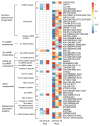Integrative Proteome and Phosphoproteome Profiling of Early Cold Response in Maize Seedlings
- PMID: 35742945
- PMCID: PMC9224472
- DOI: 10.3390/ijms23126493
Integrative Proteome and Phosphoproteome Profiling of Early Cold Response in Maize Seedlings
Abstract
Cold limits the growth and yield of maize in temperate regions, but the molecular mechanism of cold adaptation remains largely unexplored in maize. To identify early molecular events during cold shock, maize seedlings were treated under 4 °C for 30 min and 2 h, and analyzed at both the proteome and phosphoproteome levels. Over 8500 proteins and 19,300 phosphopeptides were quantified. About 660 and 620 proteins were cold responsive at protein abundance or site-specific phosphorylation levels, but only 65 proteins were shared between them. Functional enrichment analysis of cold-responsive proteins and phosphoproteins revealed that early cold response in maize is associated with photosynthesis light reaction, spliceosome, endocytosis, and defense response, consistent with similar studies in Arabidopsis. Thirty-two photosynthesis proteins were down-regulated at protein levels, and 48 spliceosome proteins were altered at site-specific phosphorylation levels. Thirty-one kinases and 33 transcriptional factors were cold responsive at protein, phosphopeptide, or site-specific phosphorylation levels. Our results showed that maize seedlings respond to cold shock rapidly, at both the proteome and phosphoproteome levels. This study provides a comprehensive landscape at the cold-responsive proteome and phosphoproteome in maize seedlings that can be a significant resource to understand how C4 plants respond to a sudden temperature drop.
Keywords: TMT-labeling; cold stress; maize; phosphoproteome; photosynthesis; proteome; seedlings; spliceosome.
Conflict of interest statement
The authors declare no conflict of interest. The funders had no role in the design of the study; in the collection, analyses, or interpretation of data; in the writing of the manuscript; or in the decision to publish the results.
Figures









Similar articles
-
Data-Independent Acquisition-Based Proteome and Phosphoproteome Profiling Reveals Early Protein Phosphorylation and Dephosphorylation Events in Arabidopsis Seedlings upon Cold Exposure.Int J Mol Sci. 2021 Nov 27;22(23):12856. doi: 10.3390/ijms222312856. Int J Mol Sci. 2021. PMID: 34884660 Free PMC article.
-
Quantitative analysis of changes in the phosphoproteome of maize induced by the plant hormone salicylic acid.Sci Rep. 2015 Dec 11;5:18155. doi: 10.1038/srep18155. Sci Rep. 2015. PMID: 26659305 Free PMC article.
-
Phosphoproteomic Analysis of Maize Seedlings Provides Insights into the Mechanisms of Heat-Stress Tolerance.Int J Mol Sci. 2025 Mar 9;26(6):2439. doi: 10.3390/ijms26062439. Int J Mol Sci. 2025. PMID: 40141083 Free PMC article.
-
A dynamic phosphoproteomic analysis provides insight into the C4 plant maize (Zea mays L.) response to natural diurnal changes.Plant J. 2023 Jan;113(2):291-307. doi: 10.1111/tpj.16047. Epub 2022 Dec 17. Plant J. 2023. PMID: 36440987
-
Maize proteomics: an insight into the biology of an important cereal crop.Proteomics. 2013 Feb;13(3-4):637-62. doi: 10.1002/pmic.201200275. Epub 2013 Jan 24. Proteomics. 2013. PMID: 23197376 Review.
Cited by
-
Large-scale phosphoproteome analysis in wheat seedling leaves provides evidence for extensive phosphorylation of regulatory proteins during CWMV infection.BMC Plant Biol. 2023 Nov 2;23(1):532. doi: 10.1186/s12870-023-04559-3. BMC Plant Biol. 2023. PMID: 37914991 Free PMC article.
-
Integrative Proteomic and Phosphoproteomic Analyses Revealed the Regulatory Mechanism of the Response to Ultraviolet B Stress in Clematis terniflora DC.ACS Omega. 2022 Dec 29;8(1):1652-1662. doi: 10.1021/acsomega.2c07258. eCollection 2023 Jan 10. ACS Omega. 2022. PMID: 36643485 Free PMC article.
-
Chilling stress response in tobacco seedlings: insights from transcriptome, proteome, and phosphoproteome analyses.Front Plant Sci. 2024 May 28;15:1390993. doi: 10.3389/fpls.2024.1390993. eCollection 2024. Front Plant Sci. 2024. PMID: 38872895 Free PMC article.
-
Phenotypic and Proteomic Insights into Differential Cadmium Accumulation in Maize Kernels.Genes (Basel). 2023 Dec 13;14(12):2204. doi: 10.3390/genes14122204. Genes (Basel). 2023. PMID: 38137026 Free PMC article.
-
Overexpression of ZmDHN15 Enhances Cold Tolerance in Yeast and Arabidopsis.Int J Mol Sci. 2022 Dec 28;24(1):480. doi: 10.3390/ijms24010480. Int J Mol Sci. 2022. PMID: 36613921 Free PMC article.
References
-
- Frascaroli E., Revilla P. The Maize Genome. Springer; Cham, Switzerland: 2018. Genomics of cold tolerance in maize; pp. 287–303.
-
- Farooq M., Aziz T., Wahid A., Lee D.J., Siddique K.H.M. Chilling tolerance in maize: Agronomic and physiological approaches. Crop. Pasture Sci. 2009;60:501–516. doi: 10.1071/CP08427. - DOI
MeSH terms
Substances
Grants and funding
LinkOut - more resources
Full Text Sources
Miscellaneous

